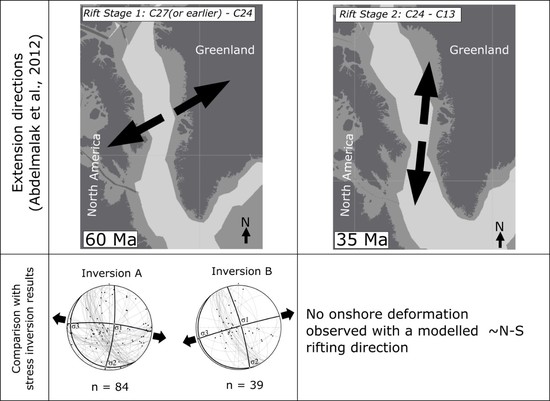Evidence for Basement Reactivation during the Opening of the Labrador Sea from the Makkovik Province, Labrador, Canada: Insights from Field Data and Numerical Models
Abstract
:1. Introduction
2. Geological Setting
3. Field Data Acquisition and Stress Inversion
3.1. Field-Based Methods
3.1.1. Field Data Acquisition
3.1.2. Stress Inversion of Field Data
3.2. Field Observations and Stress Inversion Results
3.2.1. Basement Metamorphic Mineral Foliation
3.2.2. Brittle Deformation
3.2.3. Results of Stress Inversion of Field Data
4. Structural Reactivation Modelling
4.1. Structural Reactivation Modelling Methodology
4.2. Structural Reactivation Modelling Results
5. Geopotential Stress Field Modelling
5.1. Geopotential Stress Field Modelling Methodology
5.2. Reconstructed Geopotential Stress Field Results
6. Discussion
6.1. Stress Inversion
6.2. Geopotential Stress Field Modelling
6.3. An Onshore Expression of Mesozoic Rifting?
6.4. Basement Fabric and Mesozoic Rifting
7. Conclusions
Author Contributions
Funding
Acknowledgments
Conflicts of Interest
References
- McKenzie, D. Some remarks on the development of sedimentary basins. Earth Planet. Sci. Lett. 1978, 40, 25–32. [Google Scholar] [CrossRef] [Green Version]
- Reston, T.J.; Gaw, V.; Pennell, J.; Klaeschen, D.; Stubenrauch, A.; Walker, I. Extreme crustal thinning in the south Porcupine Basin and the nature of the Porcupine Median High: Implications for the formation of non-volcanic rifted margins. J. Geol. Soc. 2004, 161, 783–798. [Google Scholar] [CrossRef]
- Lister, G.S.; Etheridge, M.A.; Symonds, P.A. Detachment models for the formation of passive continental margins. Tectonics 1991, 10, 1038–1064. [Google Scholar] [CrossRef]
- Van Wijk, J.W.; Huismans, R.S.; ter Voorde, M.; Cloetingh, S.A.P.L. Melt generation at volcanic continental margins: No need for a mantle plume? Geophys. Res. Lett. 2001, 28, 3995–3998. [Google Scholar] [CrossRef] [Green Version]
- Schofield, N.; Jolley, D.; Holford, S.; Archer, S.; Watson, D.; Hartley, A.; Howell, J.; Muirhead, D.; Underhill, J.; Green, P. Challenges of future exploration within the UK Rockall Basin. In Petroleum Geology of NW Europe: 50 Years of Learning–Proceedings of the 8th Petroleum Geology Conference; Levell, B., Bowman, M., Eds.; Geological Society: London, UK, 2018; Volume 8, pp. 211–229. [Google Scholar]
- Scotchman, I.C.; Doré, A.G.; Spencer, A.M. Petroleum systems and results of exploration on the Atlantic margins of the UK, Faroes and Ireland: What have we learnt? In Petroleum Geology of NW Europe: 50 Years of Learning–Proceedings of the 8th Petroleum Geology Conference; Levell, B., Bowman, M., Eds.; Geological Society: London, UK, 2018; Volume 8, pp. 187–197. [Google Scholar]
- Wilson, R.W.; Klint, K.E.S.; Van Gool, J.A.M.; McCaffrey, K.J.W.; Holdsworth, R.E.; Chalmers, J.A. Faults and fractures in central West Greenland: Onshore expression of continental break-up and sea-floor spreading in the Labrador–Baffin Bay Sea. Geol. Surv. Denmark Greenl. Bull. 2006, 11, 185–204. [Google Scholar]
- Abdelmalak, M.M.; Geoffroy, L.; Angelier, J.; Bonin, B.; Callot, J.P.; Gélard, J.P.; Aubourg, C. Stress fields acting during lithosphere breakup above a melting mantle: A case example in West Greenland. Tectonophysics 2012, 581, 132–143. [Google Scholar] [CrossRef]
- Ashby, D. Influences on Continental Margin Development: A Case Study from the Santos Basin, South-eastern Brazil. Ph.D. Thesis, Durham University, Durham, UK, May 2013. [Google Scholar]
- Chenin, P.; Manatschal, G.; Lavier, L.L.; Erratt, D. Assessing the impact of orogenic inheritance on the architecture, timing and magmatic budget of the North Atlantic rift system: A mapping approach. J. Geol. Soc. 2015, 172, 711–720. [Google Scholar] [CrossRef]
- Phillips, T.B.; Jackson, C.A.L.; Bell, R.E.; Duffy, O.B. Oblique reactivation of lithosphere-scale lineaments controls rift physiography—The upper crustal expression of the Sorgenfrei-Tornquist Zone, offshore southern Norway. Soild Earth 2018, 9, 403–429. [Google Scholar] [CrossRef]
- Peace, A.; McCaffrey, K.; Imber, J.; van Hunen, J.; Hobbs, R.; Wilson, R. The role of pre-existing structures during rifting, continental breakup and transform system development, offshore West Greenland. Basin Res. 2018, 30, 373–394. [Google Scholar] [CrossRef]
- Bureau, D.; Mourgues, R.; Cartwright, J.; Foschi, M.; Abdelmalak, M.M. Characterisation of interactions between a pre-existing polygonal fault system and sandstone intrusions and the determination of paleo-stresses in the Faroe-Shetland basin. J. Struct. Geol. 2013, 46, 186–199. [Google Scholar] [CrossRef]
- Peace, A.L.; Foulger, G.R.; Schiffer, C.; Mccaffrey, K.J.W. Evolution of Labrador Sea–Baffin Bay: Plate or Plume Processes? Geosci. Can. 2017, 44. [Google Scholar] [CrossRef]
- Koopmann, H.; Brune, S.; Franke, D.; Breuer, S. Linking rift propagation barriers to excess magmatism at volcanic rifted margins. Geology 2014, 42, 1071–1074. [Google Scholar] [CrossRef]
- Morley, C.K.; Haranya, C.; Phoosongsee, W.; Pongwapee, S.; Kornsawan, A.; Wonganan, N. Activation of rift oblique and rift parallel pre-existing fabrics during extension and their effect on deformation style: Examples from the rifts of Thailand. J. Struct. Geol. 2004, 26, 1803–1829. [Google Scholar] [CrossRef]
- Schiffer, C.; Peace, A.; Phethean, J.; Gernigon, L.; McCaffrey, K.J.W.; Petersen, K.D.; Foulger, G.R. The Jan Mayen Microplate Complex and the Wilson Cycle. Geol. Soc. Lond. Spec. Publ. 2018, 470. [Google Scholar] [CrossRef]
- Dore, A.G.; Lundin, E.R.; Fichler, C.; Olesen, O. Patterns of basement structure and reactivation along the NE Atlantic margin. J. Geol. Soc. 1997, 154, 85–92. [Google Scholar] [CrossRef]
- Petersen, K.D.; Schiffer, C. Wilson cycle passive margins: Control of orogenic inheritance on continental breakup. Gondwana Res. 2016, 39, 131–144. [Google Scholar] [CrossRef]
- Smith, W.H.; Sandwell, D. Global Sea Floor Topography from Satellite Altimetry and Ship Depth Soundings. Science 1997, 277, 1956–1962. [Google Scholar] [CrossRef]
- Seton, M.; Müller, R.D.; Zahirovic, S.; Gaina, C.; Torsvik, T.; Shephard, G.; Talsma, A.; Gurnis, M.; Turner, M.; Maus, S.; et al. Global continental and ocean basin reconstructions since 200Ma. Earth-Sci. Rev. 2012, 113, 212–270. [Google Scholar] [CrossRef] [Green Version]
- Peace, A.; McCaffrey, K.J.W.; Imber, J.; Phethean, J.; Nowell, G.; Gerdes, K.; Dempsey, E. An evaluation of Mesozoic rift-related magmatism on the margins of the Labrador Sea: Implications for rifting and passive margin asymmetry. Geosphere 2016, 12, 1701–1724. [Google Scholar] [CrossRef] [Green Version]
- LaFlamme, C.; Sylvester, P.J.; Hinchey, A.M.; Davis, W.J. U-Pb age and Hf-isotope geochemistry of zircon from felsic volcanic rocks of the Paleoproterozoic Aillik Group, Makkovik Province, Labrador. Precambrian Res. 2013, 224, 129–142. [Google Scholar] [CrossRef]
- Kerr, A.; Hall, J.; Wardle, R.J.; Gower, C.F.; Ryan, B. New reflections on the structure and evolution of the Makkovikian-Ketilidian Orogen in Labrador and southern Greenland. Tectonics 1997, 16, 942–965. [Google Scholar] [CrossRef]
- Japsen, P.; Bonow, J.M.; Peulvast, J.P.; Wilson, R.W. Uplift, Erosion and Fault Reactivation in Southern West Greenland, Field Reports; Geological Survey of Denmark and Greenland: Kobenhavn, Denmak, 2006. [Google Scholar]
- Wilson, R.W.; McCaffrey, K.J.W.; Holdsworth, R.E.; Peace, A.; Imber, J.; GEUS. Tectonic inheritance during extension in rifts and passive margins: Greenland’s playground for basement inheritance. In Proceedings of the Arthur Holmes Meeting 2016: The Wilson Cycle: Plate Tectonics and Structural Inheritance during Continental Deformation, London, UK, 23–25 May 2016. [Google Scholar]
- Chalmers, J.A.; Pulvertaft, T.C.R. Development of the continental margins of the Labrador Sea: A review. Geol. Soc. Lond. Spec. Publ. 2001, 187, 77–105. [Google Scholar] [CrossRef]
- Delescluse, M.; Funck, T.; Dehler, S.A.; Louden, K.E.; Watremez, L. The oceanic crustal structure at the extinct, slow to ultraslow Labrador Sea spreading center. J. Geophys. Res. B Solid Earth 2015, 120, 5249–5272. [Google Scholar] [CrossRef] [Green Version]
- Chalmers, J.A.; Laursen, K.H. Labrador Sea: The extent of continental and oceanic crust and the timing of the onset of seafloor spreading. Mar. Pet. Geol. 1995, 12, 205–217. [Google Scholar] [CrossRef]
- Chian, D.; Louden, K.E.; Reid, I. Crustal structure of the Labrador Sea conjugate margin and implications for the formation of nonvolcanic continental margins. J. Geophys. Res. Solid Eaeth Banner 1995, 100, 24239–24253. [Google Scholar] [CrossRef]
- Gerlings, J.; Funck, T.; Jackson, H.R.; Louden, K.E.; Klingelhofer, F. Seismic evidence for plume-derived volcanism during formation of the continental margin in southern Davis Strait and northern Labrador Sea. Geophys. J. Int. 2009, 176, 980–994. [Google Scholar] [CrossRef] [Green Version]
- Keen, C.E.; Dickie, K.; Dafoe, L.T. Structural characteristics of the ocean-continent transition along the rifted continental margin, offshore central Labrador. Mar. Pet. Geol. 2018, 89, 443–463. [Google Scholar] [CrossRef]
- Larsen, L.M.; Heaman, L.M.; Creaser, R.A.; Duncan, R.A.; Frei, R.; Hutchison, M. Tectonomagmatic events during stretching and basin formation in the Labrador Sea and the Davis Strait: Evidence from age and composition of Mesozoic to Palaeogene dyke swarms in West Greenland. J. Geol. Soc. 2009, 166, 999–1012. [Google Scholar] [CrossRef]
- Umpleby, D.C. Geology of the Labrador Shelf; Geological Survey of Canada: Ottawa, Canada, 1979. [Google Scholar]
- Hansen, K. Lamprophyres and carbonatitic lamprophyres related to rifting in the Labrador Sea. Lithos 1980, 13, 145–152. [Google Scholar] [CrossRef]
- Tappe, S.; Foley, S.F.; Stracke, A.; Romer, R.L.; Kjarsgaard, B.A.; Heaman, L.M.; Joyce, N. Craton reactivation on the Labrador Sea margins: 40Ar/39Ar age and Sr-Nd-Hf-Pb isotope constraints from alkaline and carbonatite intrusives. Earth Planet. Sci. Lett. 2007, 256, 433–454. [Google Scholar] [CrossRef]
- Chalmers, J.A. The continental margin off southern Greenland: Along-strike transition from an amagmatic to a volcanic margin. J. Geol. Soc. 1997, 154, 571–576. [Google Scholar] [CrossRef]
- Storey, M.; Duncan, R.A.; Pedersen, A.K.; Larsen, L.M.; Larsen, H.C. 40Ar/39Ar geochronology of the West Greenland Tertiary volcanic province. Earth Planet. Sci. Lett. 1998, 160, 569–586. [Google Scholar] [CrossRef]
- Keen, C.E.; Dickie, K.; Dehler, S.A. The volcanic margins of the northern Labrador Sea: Insights to the rifting process. Tectonics 2012, 31, 1–13. [Google Scholar] [CrossRef]
- Ketchum, J.W.F.; Culshaw, N.G.; Barr, S.M. Anatomy and orogenic history of a Paleoproterozoic accretionary belt: The Makkovik Province, Labrador, Canada. Can. J. Earth Sci. 2002, 39, 711–730. [Google Scholar] [CrossRef]
- Hinchey, A.M. Geology of the Makkovik Area, Labrador (NTS 13O/03 and parts of NTS 13O/02). Available online: https://www.nr.gov.nl.ca/nr/mines/maps/lab/html_lb/images/Map2013-07.pdf (accessed on 20 August 2018).
- Culshaw, N.; Brown, T.; Reynolds, P.H.; Ketchum, J.W.F. Kanairiktok shear zone: The boundary between the Paleoproterozoic Makkovik Province and the Archean Nain Province, Labrador, Canada. Can. J. Earth Sci. 2000, 37, 1245–1257. [Google Scholar] [CrossRef]
- St-Onge, M.R.; Van Gool, J.A.M.; Garde, A.A.; Scott, D.J. Correlation of Archaean and Palaeoproterozoic units between northeastern Canada and western Greenland: Constraining the pre-collisional upper plate accretionary history of the Trans-Hudson orogen. Geol. Soc. Lond. Spec. Publ. 2009, 318, 193–235. [Google Scholar] [CrossRef]
- Garde, A.A.; Hamilton, M.A.; Chadwick, B.; Grocott, J.; McCaffrey, K.J.W. The Ketilidian orogen of South Greenland: Geochronology, tectonics, magmatism, and fore-arc accretion during Palaeoproterozoic oblique convergence. Can. J. Earth Sci. 2002, 39, 765–793. [Google Scholar] [CrossRef]
- Wardle, R.J.; Gower, C.F.; James, D.T.; St-Onge, M.R.; Scott, D.J.; Garde, A.A.; Culshaw, N.G.; van Gool, J.A.; Connelly, J.N.; Perreault, S.; et al. Correlation chart of the Proterozoic assembly of the northeastern Canadian-Greenland Shield. Can. J. Earth Sci. 2002, 39, 895. [Google Scholar] [CrossRef]
- McCaffrey, K.J.W.; Grocott, J.; Garde, A.A.; Hamilton, M.A. Attachment formation during partitioning of oblique convergence in the Ketilidian orogen, south Greenland. Geol. Soc. Lond. Spec. Publ. 2004, 227, 231–248. [Google Scholar] [CrossRef]
- Kerr, A.; Ryan, B.; Gower, C.F.; Wardle, R.J. The Makkovik Province: Extension of the Ketilidian Mobile Belt in mainland North America. Geol. Soc. Lond. Spec. Publ. 1996, 112, 155–177. [Google Scholar] [CrossRef]
- Angelier, J. Inversion of field data in fault tectonics to obtain the regional stress-III. A new rapid direct inversion method by analytical means. Geophys. J. Int. 1990, 103, 363–376. [Google Scholar] [CrossRef] [Green Version]
- Bott, M.H.P. The Mechanics of Oblique Slip Faulting. Geol. Mag. 1959, 96, 109–117. [Google Scholar] [CrossRef]
- Michael, A.J. Determination of stress from slip data: Faults and folds. J. Geophys. Res. 1984, 89, 11517–11526. [Google Scholar] [CrossRef]
- Dempsey, E.D.; Holdsworth, R.E.; Imber, J.; Bistacchi, A.; Di Toro, G. A geological explanation for intraplate earthquake clustering complexity: The zeolite-bearing fault/fracture networks in the Adamello Massif (Southern Italian Alps). J. Struct. Geol. 2014, 66, 58–74. [Google Scholar] [CrossRef] [Green Version]
- Abdunaser, K.M.; McCaffrey, K.J.W. A new structural interpretation relating NW Libya to the Hun Graben, western Sirt Basin based on a new paleostress inversion. J. Earth Syst. Sci. 2015, 124, 1745–1763. [Google Scholar] [CrossRef]
- Dichiarante, A.M.; Holdsworth, R.E.; Dempsey, E.D.; Selby, D.; McCaffrey, K.J.W.; Michie, U.M.; Morgan, G.; Bonniface, J. New structural and Re-Os geochronological evidence constraining the age of faulting and associated mineralization in the Devonian Orcadian Basin, Scotland. J. Geol. Soc. 2016, 173, 457–473. [Google Scholar] [CrossRef] [Green Version]
- Oakey, G.N.; Chalmers, J. A new model for the Paleogene motion of Greenland relative to North America: Plate reconstructions of the Davis Strait and Nares Strait regions between Canada and Greenland. J. Geophys. Res. Solid Earth 2012, 117, 1–28. [Google Scholar] [CrossRef]
- Arne, D.C.; Grist, A.M.; Zentilli, M.; Collins, M.; Embry, A.; Gentzis, T. Cooling of the Sverdrup Basin during Tertiary basin inversion: Implications for hydrocarbon exploration. Basin Res. 2002, 14, 183–205. [Google Scholar] [CrossRef]
- Holford, S.P.; Tuitt, A.K.; Hillis, R.R.; Green, P.F.; Stoker, M.S.; Duddy, I.R.; Sandiford, M.; Tassone, D.R. Cenozoic deformation in the Otway Basin, southern Australian margin: Implications for the origin and nature of post-breakup compression at rifted margins. Basin Res. 2014, 26, 10–37. [Google Scholar] [CrossRef] [Green Version]
- Tappe, S.; Foley, S.F.; Jenner, G.A.; Heaman, L.M.; Kjarsgaard, B.A.; Romer, R.L.; Stracke, A.; Joyce, N.; Hoefs, J. Genesis of ultramafic lamprophyres and carbonatites at Aillik Bay, Labrador: A consequence of incipient lithospheric thinning beneath the North Atlantic Craton. J. Petrol. 2006, 47, 1261–1315. [Google Scholar] [CrossRef]
- Foley, S.F. Emplacement Features of Lamprophyre and Carbonatitic Lamprophyre Dykes at Aillik Bay, Labrador. Geol. Mag. 1989, 126, 29–42. [Google Scholar] [CrossRef]
- Cardozo, N.; Allmendinger, R.W. Spherical projections with OSXStereonet. Comput. Geosci. 2013, 51, 193–205. [Google Scholar] [CrossRef]
- Woodcock, N.H.; Mort, K.M. Classification of fault breccias and related fault rocks. Geol. Mag. 2008, 145, 435–440. [Google Scholar] [CrossRef]
- Hobbs, B.E.; Means, W.D.; Williams, P.F. An Outline of Structural Geology; John Wiley & Sons: New York, NY, USA, 1976. [Google Scholar]
- Jaeger, J.C.; Cook, N.G.W. Fundamentals of Rock Mechanics, 3rd ed.; Chapman and Hall: London, UK, 1979. [Google Scholar]
- Morris, A.; Ferrill, D.A.; Henderson, D.B.; Morris, A.; Ferrill, D.A.; Henderson, D.B. Slip-tendency analysis and fault reactivation. Geology 1996, 24, 275–278. [Google Scholar] [CrossRef]
- Lisle, R.J.; Srivastava, D.C. Test of the frictional reactivation theory for faults and validity of fault-slip analysis. Geology 2004, 32, 569–572. [Google Scholar] [CrossRef]
- Neves, M.C.; Paiva, L.T.; Luis, J. Software for slip-tendency analysis in 3D: A plug-in for Coulomb. Comput. Geosci. 2009, 35, 2345–2352. [Google Scholar] [CrossRef]
- Moeck, I.; Kwiatek, G.; Zimmermann, G. Slip tendency analysis, fault reactivation potential and induced seismicity in a deep geothermal reservoir. J. Struct. Geol. 2009, 31, 1174–1182. [Google Scholar] [CrossRef] [Green Version]
- Schiffer, C.; Nielsen, S.B. Implications for anomalous mantle pressure and dynamic topography from lithospheric stress patterns in the North Atlantic Realm. J. Geodyn. 2016, 98, 53–69. [Google Scholar] [CrossRef]
- Nielsen, S.B.; Stephenson, R.A.; Schiffer, C. Deep controls on intraplate basin inversion. In Intraplate Earthquakes; Talwani, P., Ed.; Cambridge University Press: Cambridge, UK, 2014; pp. 257–274. [Google Scholar]
- Bouhifd, M.A.; Andrault, D.; Fiquet, G.; Richet, P. Thermal expansion of forsterite up to the melting point. Geophys. Res. Lett. 1996, 23, 1143–1146. [Google Scholar] [CrossRef]
- McKenzie, D.; Jackson, J.; Priestley, K. Thermal structure of oceanic and continental lithosphere. Earth Planet. Sci. Lett. 2005, 233, 337–349. [Google Scholar] [CrossRef]
- Bird, P.; Piper, K. Plane-stress finite-element models of tectonic flow in southern California. Phys. Earth Planet. Inter. 1980, 21, 158–175. [Google Scholar] [CrossRef]
- England, P.; Houseman, G. Finite strain calculations of continental deformation: 2. Comparison with the India-Asia Collision Zone. J. Geophys. Res. Solid Earth 1986, 91, 3664–3676. [Google Scholar] [CrossRef]
- England, P.; McKenzie, D. A thin viscous sheet model for continental deformation. Geophys. J. R. Astron. Soc. 1982, 70, 295–321. [Google Scholar] [CrossRef] [Green Version]
- Zienkiewicz. The Finite Element Method, 3rd ed.; McGraw-Hill: Berkshire, UK, 1977. [Google Scholar]
- Flesch, L.M.; Haines, A.J.; Holt, W.E. Dynamics of the India-Eurasia collision zone. J. Geophys. Res. Solid Earth 2001, 106, 16435–16460. [Google Scholar] [CrossRef] [Green Version]
- Ghosh, A.; Holt, W.E.; Wen, L.; Haines, A.J.; Flesch, L.M. Joint modeling of lithosphere and mantle dynamics elucidating lithosphere-mantle coupling. Geophys. Res. Lett. 2008, 35. [Google Scholar] [CrossRef] [Green Version]
- Schiffer, C.; Tegner, C.; Schaeffer, A.J.; Pease, V.; Nielsen, S.B. High arctic geopotential stress field and implications for geodynamic evolution. Geol. Soc. Spec. Publ. 2018, 460. [Google Scholar] [CrossRef]
- Müller, R.D.; Sdrolias, M.; Gaina, C.; Steinberger, B.; Heine, C. Long-term sea-level fluctuations driven by ocean basin dynamics. Science 2008, 319, 1357–1362. [Google Scholar]
- Arthur, M.A.; Srivastava, S.P.; Kaminski, M.; Jarrard, R.; Osler, J. Seismic stratigraphy and history of deep circulation and sediment drift development in Baffin Bay and the Labrador Sea. In Proceedings of the Ocean Drilling Program: Scientific Results; Texas A&M University: Texas, TX, USA, 1989; Volume 105, pp. 957–988. [Google Scholar]
- Cloetingh, S.; Gradstein, F.M.; Kooi, H.; Grant, A.C.; Kaminski, M.M. Plate reorganization: A cause of rapid late Neogene subsidence and sedimentation around the North Atlantic? J. Geol. Soc. 1990, 147, 495–506. [Google Scholar] [CrossRef]
- Gradstein, F.M.; Srivastava, S.P. Aspects of Cenozoic stratigraphy and paleoceanography of the Labrador Sea and Baffin Bay. Palaeogeogr. Palaeoclimatol. Palaeoecol. 1980, 30, 261–295. [Google Scholar] [CrossRef]
- Piper, D.J.W. Late Cenozoic evolution of the continental margin of eastern Canada. Nor. J. Geol. 2005, 85, 305–318. [Google Scholar]
- Royden, L.; Keen, C.E. Rifting process and thermal evolution of the continental margin of Eastern Canada determined from subsidence curves. Earth Planet. Sci. Lett. 1980, 51, 343–361. [Google Scholar] [CrossRef]
- Wolf, T.C.W.; Thiede, J. History of terrigenous sedimentation during the past 10 my in the North Atlantic (ODP Legs 104 and 105 and DSDP Leg 81). Mar. Geol. 1991, 101, 83–102. [Google Scholar] [CrossRef]
- Tarantola, A.; Valette, B. Generalized nonlinear inverse problems solved using the least squares criterion. Rev. Geophys. 1982, 20, 219–232. [Google Scholar] [CrossRef]
- De Lamotte, D.F.; Fourdan, B.; Leleu, S.; Leparmentier, F.; De Clarens, P. Style of rifting and the stages of Pangea breakup. Tectonics 2015, 34, 1009–1029. [Google Scholar] [CrossRef] [Green Version]
- Hosseinpour, M.; Müller, R.D.; Williams, S.E.; Whittaker, J.M. Full-fit reconstruction of the labrador sea and baffin bay. Solid Earth 2013, 4, 461–479. [Google Scholar] [CrossRef]
- Hatcher, R. The Appalachian orogen: A brief summary. In From Rodinia to Pangea: The Lithotectonic Record of the Appalachian Region; Geological Society of America: Boulder, CO, USA, 2010. [Google Scholar]
- Haworth, R.T.; Hipkin, R.; Jacobi, R.D.; Kane, M.; Lefort, J.P.; Max, M.D.; Miller, H.G.; Wolff, F. Geophysical framework and the Appalachian-Caledonide connection. Geol. Soc. Lond. Spec. Publ. 1988, 38, 3–20. [Google Scholar] [CrossRef] [Green Version]
- Nielsen, S.B.; Stephenson, R.; Thomsen, E. Dynamics of Mid-Palaeocene North Atlantic rifting linked with European intra-plate deformations. Nature 2007, 450, 1071–1074. [Google Scholar] [CrossRef] [PubMed]
- Butler, R.W.H.; Holdsworth, R.E.; Lloyd, G.E. The role of basement reactivation in continental deformation. J. Geol. Soc. 1997, 154, 69–71. [Google Scholar] [CrossRef]
- Holdsworth, R.E.; Butler, C.A.; Roberts, A.M. The recognition of reactivation during continental deformation. J. Geol. Soc. 1997, 154, 73–78. [Google Scholar] [CrossRef]
- Holdsworth, R.E.; Handa, M.; Miller, J.A.; Buick, I.S. Continental reactivation and reworking: An introduction. Geol. Soc. Lond. Spec. Publ. 2001, 184, 1–12. [Google Scholar] [CrossRef]
- Holdsworth, R.E.; Stewart, M.; Imber, J.; Strachan, R.A. The structure and rheological evolution of reactivated continental fault zones: A review and case study. Geol. Soc. Lond. Spec. Publ. 2001, 184, 115–137. [Google Scholar] [CrossRef]
- McCaffrey, K. Controls on reactivation of a major fault zone: The Fair Head-Clew Bay line in Ireland. J. Geol. Soc. 1997, 154, 129–133. [Google Scholar] [CrossRef]
- Bellahsen, N.; Fournier, M.; d’Acremont, E.; Leroy, S.; Daniel, J.M. Fault reactivation and rift localization: Northeastern Gulf of Aden margin. Tectonics 2006, 25, 1–14. [Google Scholar] [CrossRef]
- Autin, J.; Bellahsen, N.; Leroy, S.; Husson, L.; Beslier, M.O.; D’Acremont, E. The role of structural inheritance in oblique rifting: Insights from analogue models and application to the Gulf of Aden. Tectonophysics 2013, 607, 51–64. [Google Scholar] [CrossRef] [Green Version]
- Wilson, R.W.; Holdsworth, R.E.; Wild, L.E.; McCaffrey, K.J.W.; England, R.W.; Imber, J.; Strachan, R.A. Basement-influenced rifting and basin development: A reappraisal of post-Caledonian faulting patterns from the North Coast Transfer Zone, Scotland. Geol. Soc. Lond. Spec. Publ. 2010, 335, 795–826. [Google Scholar] [CrossRef]
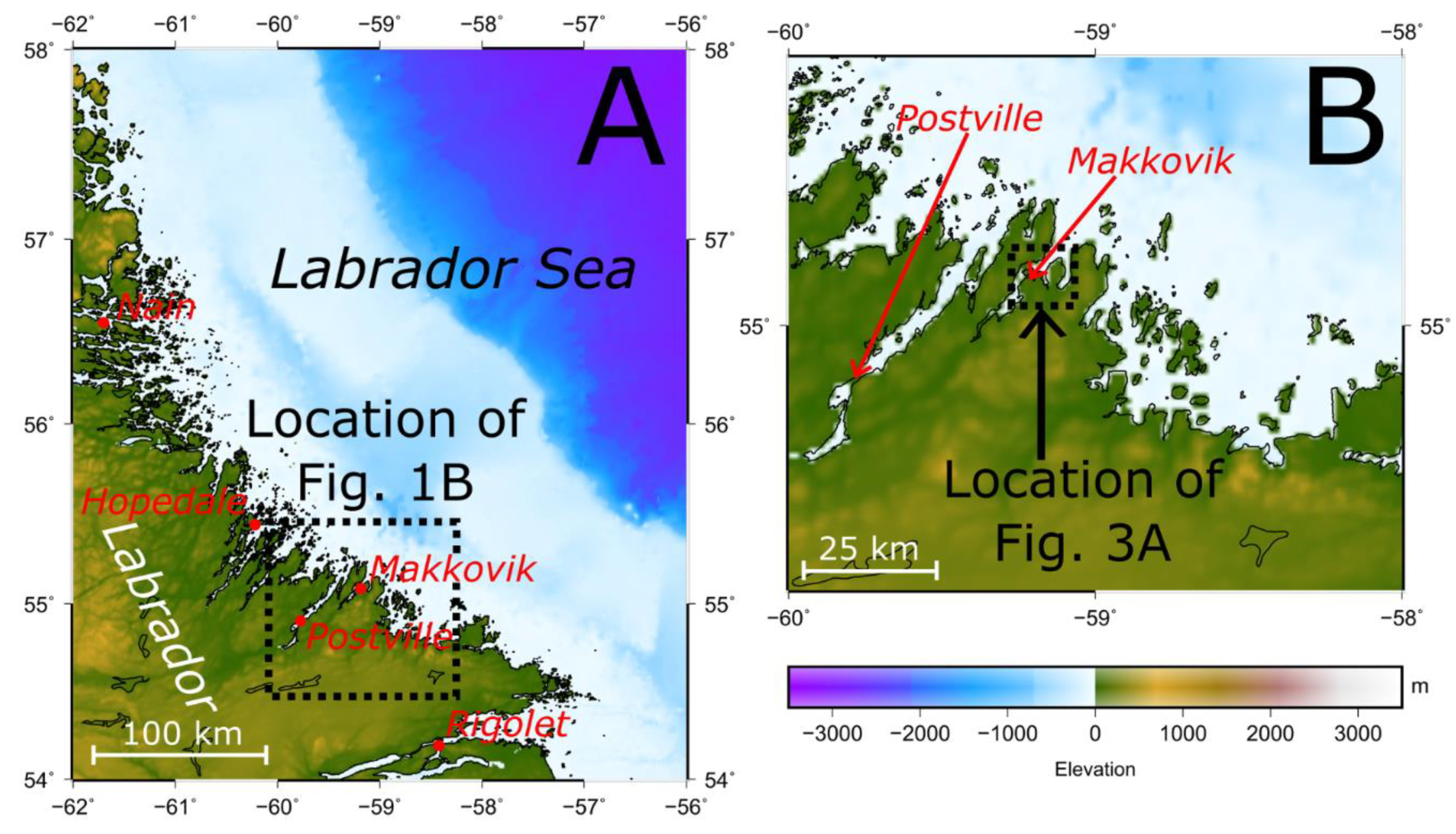
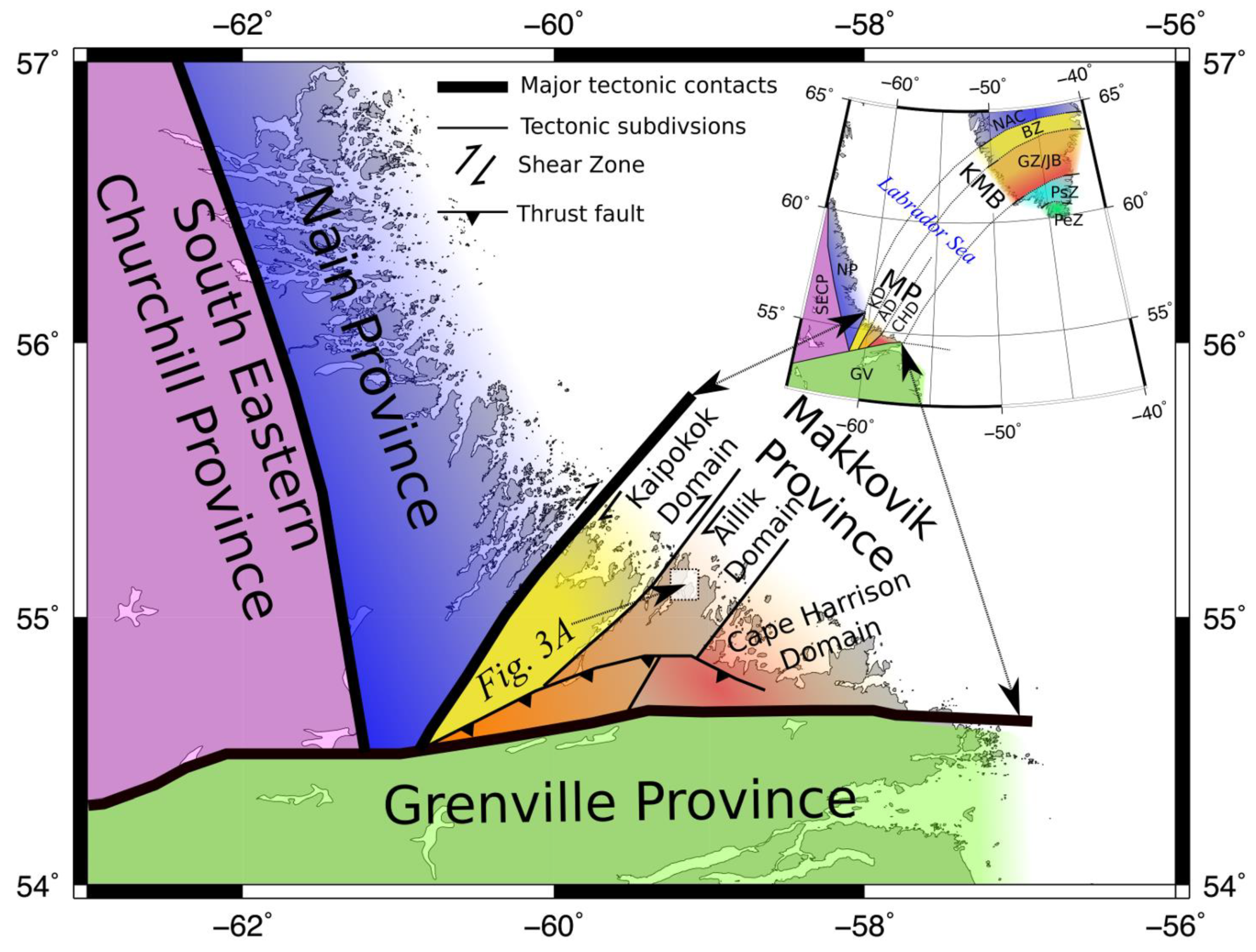


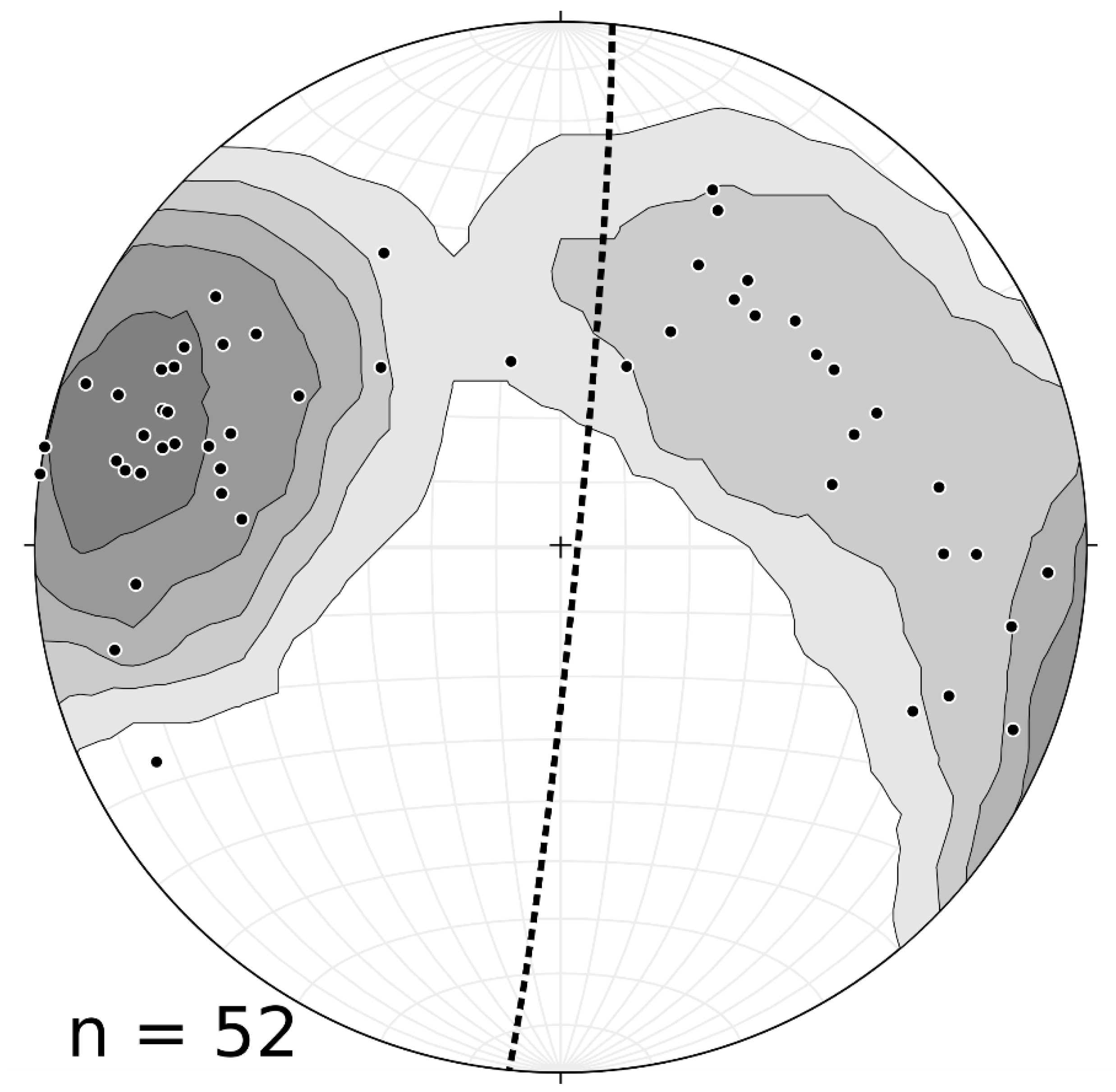


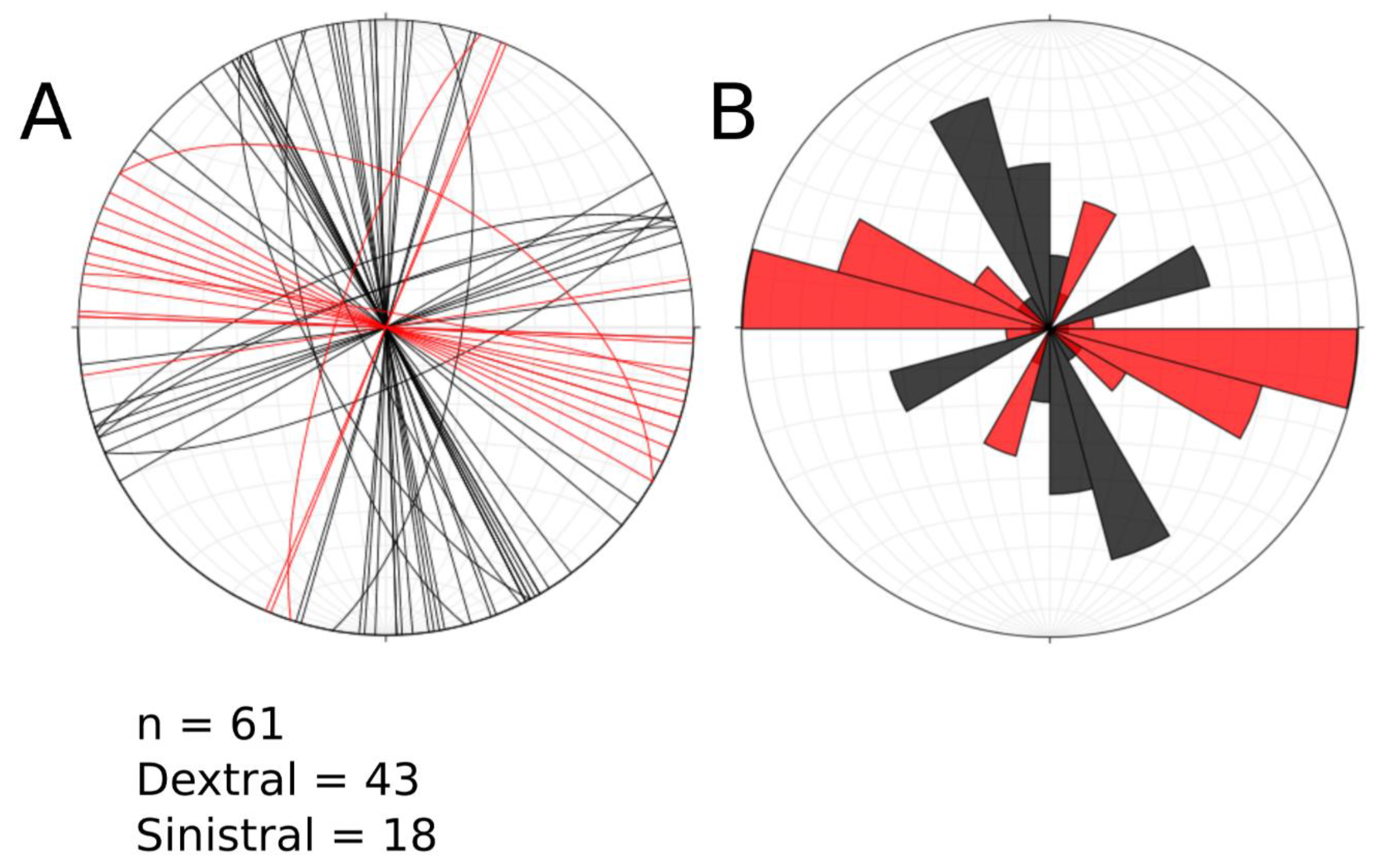
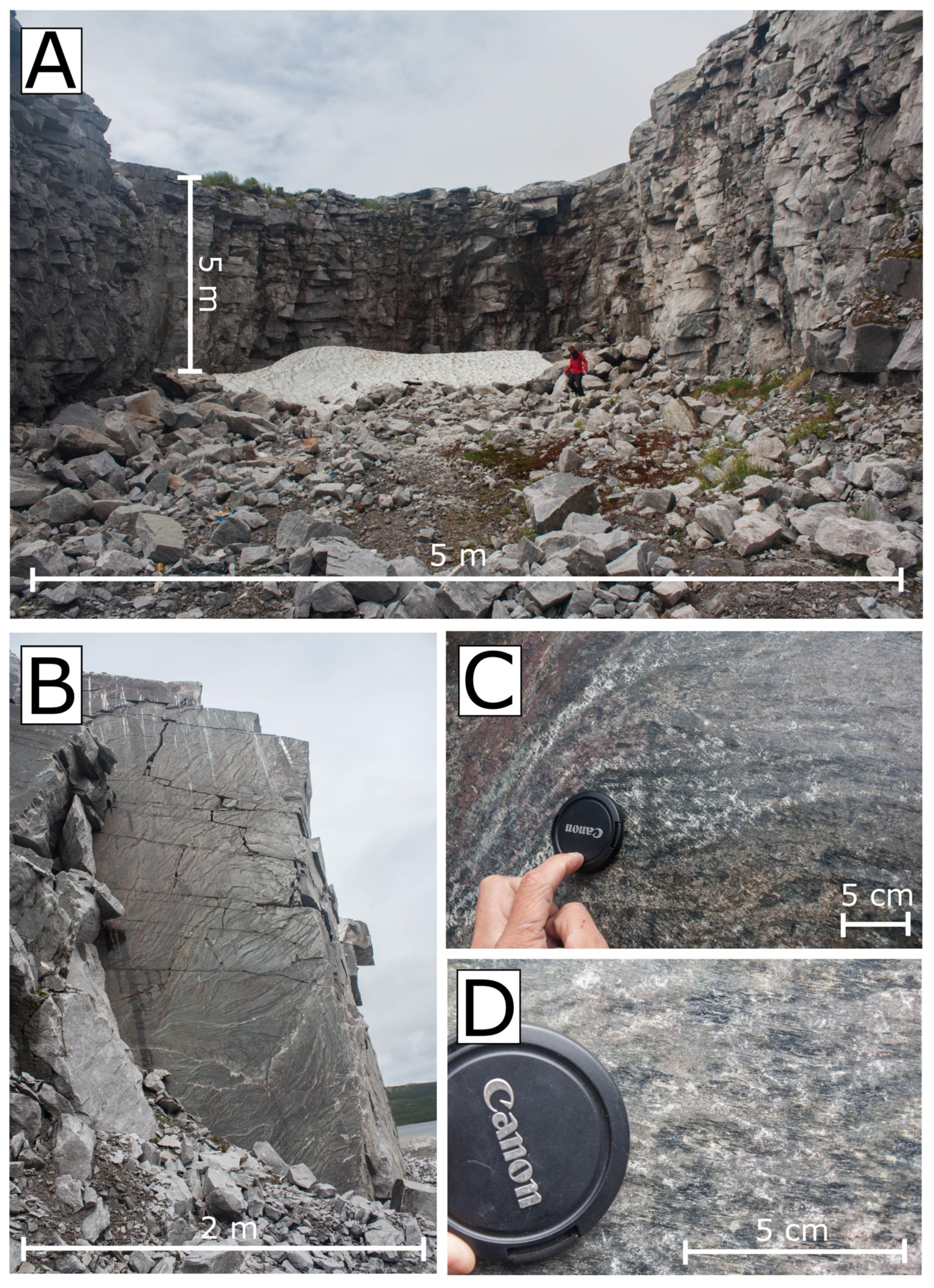
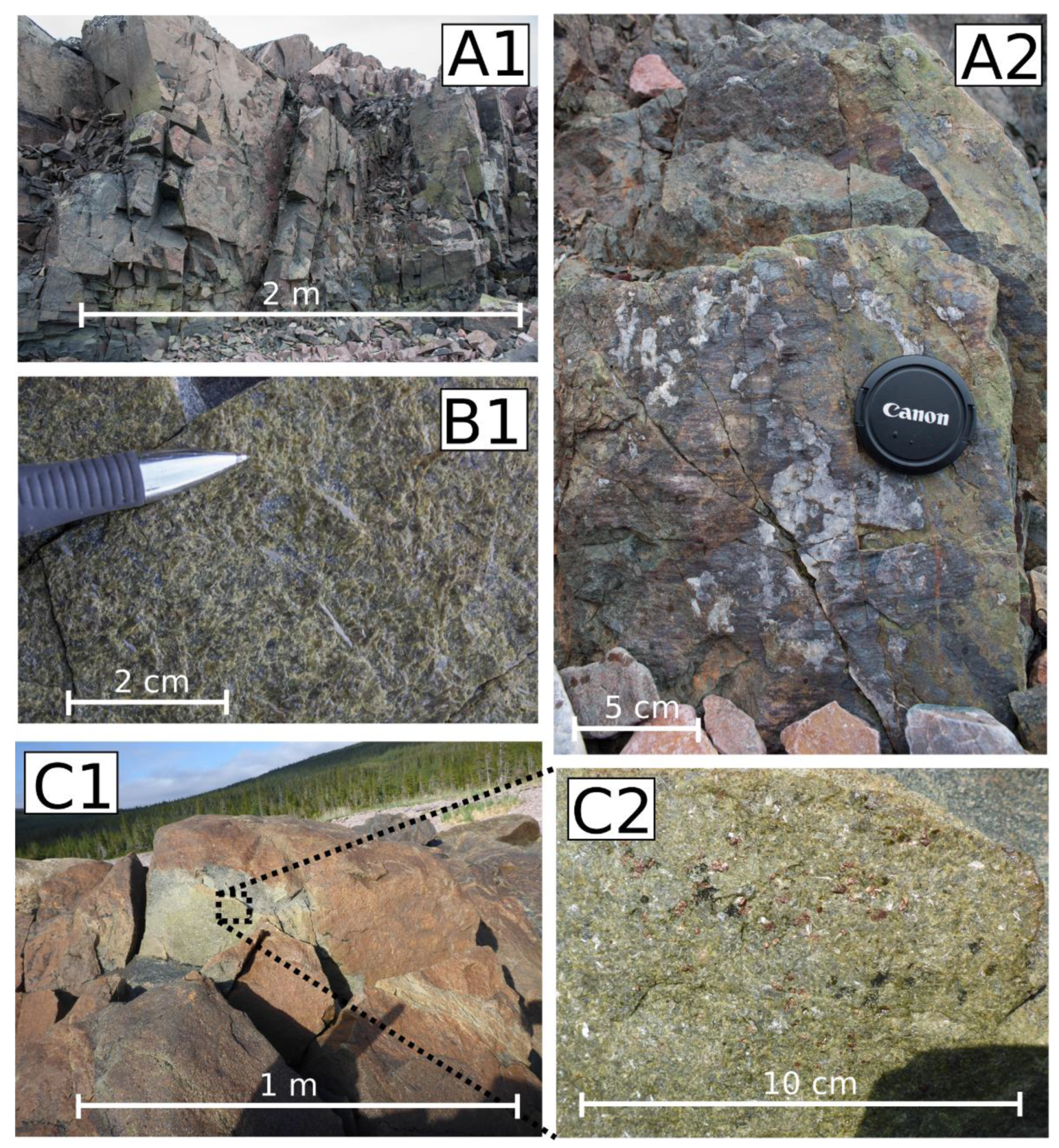
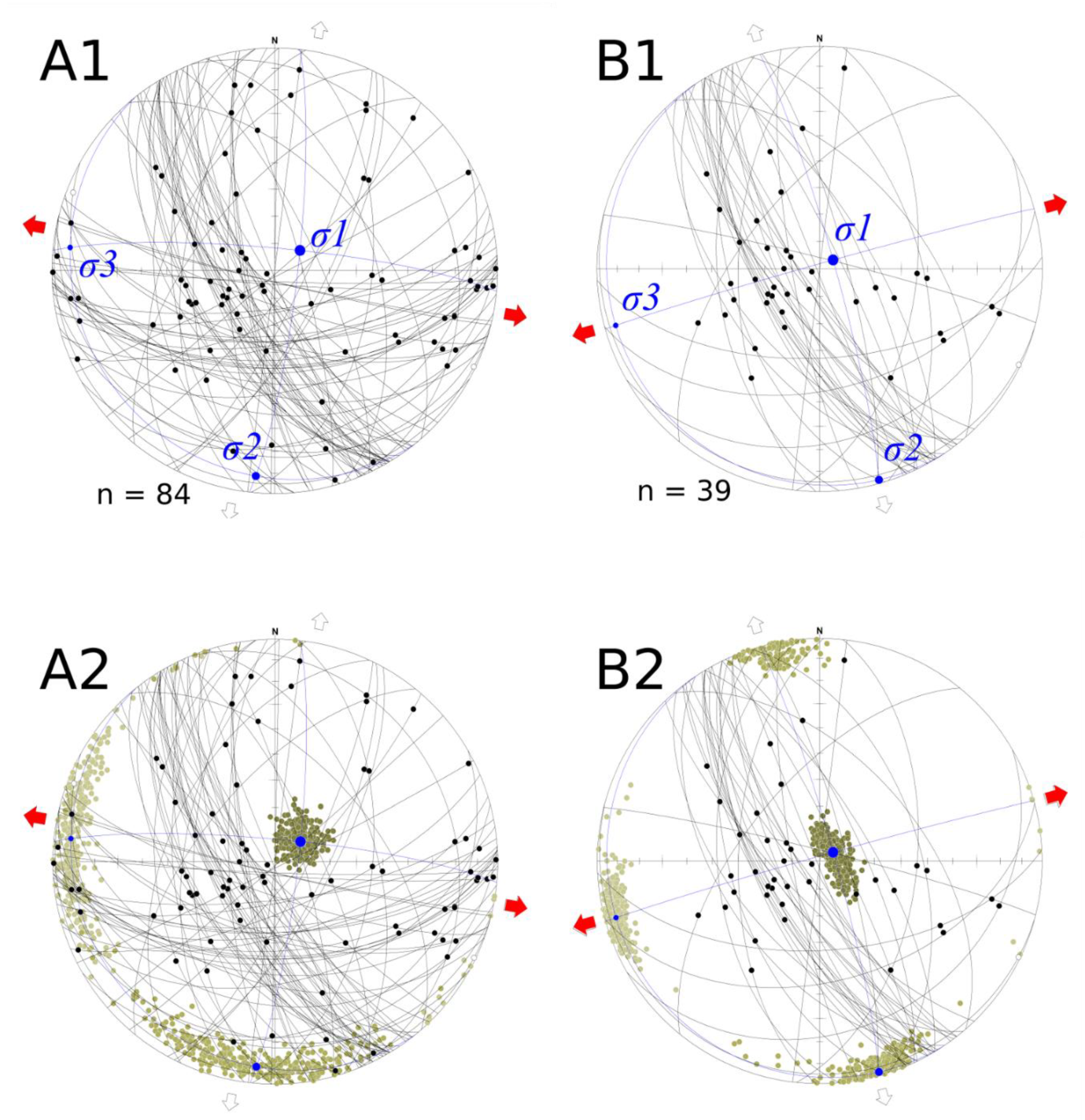

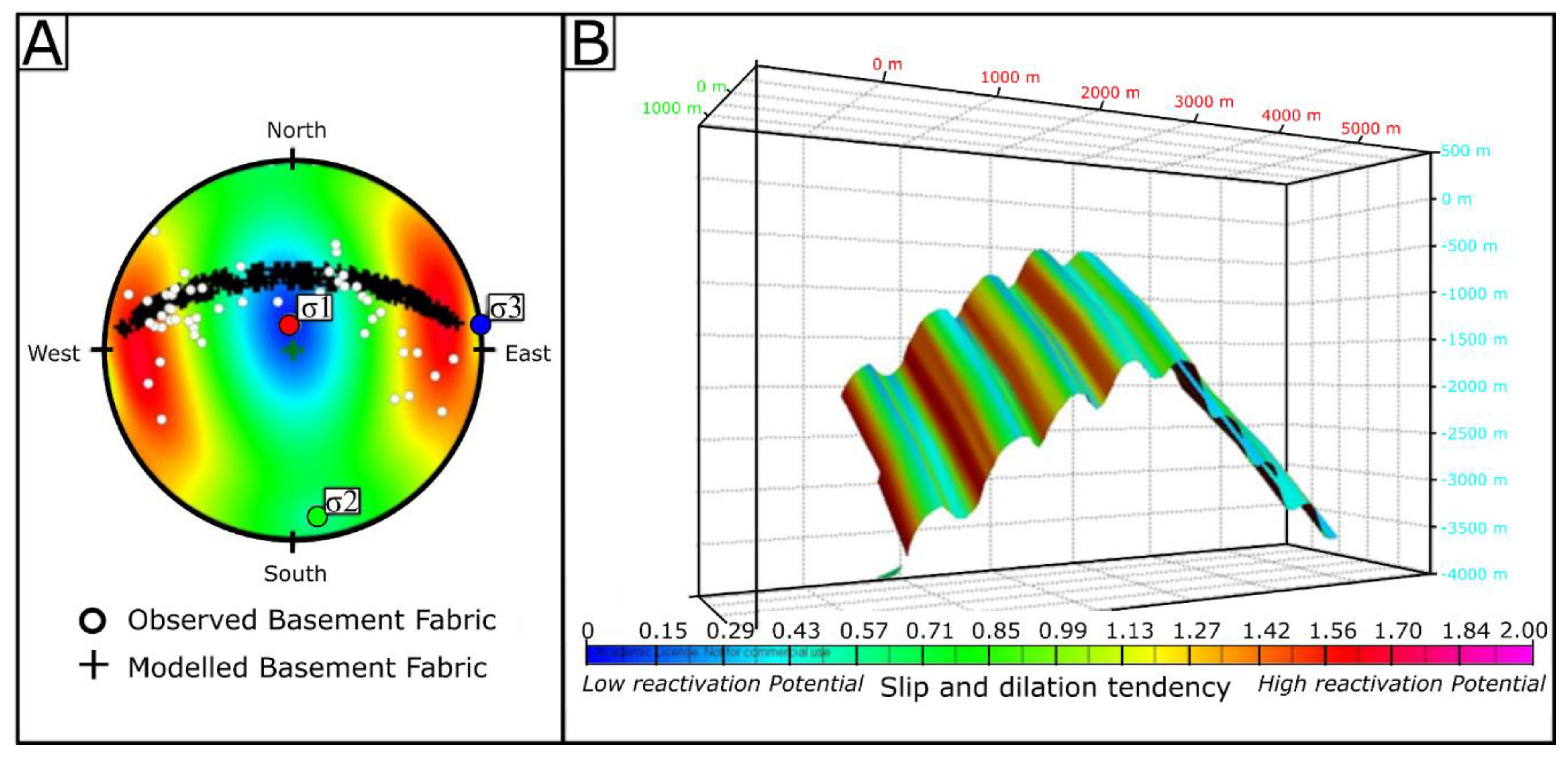
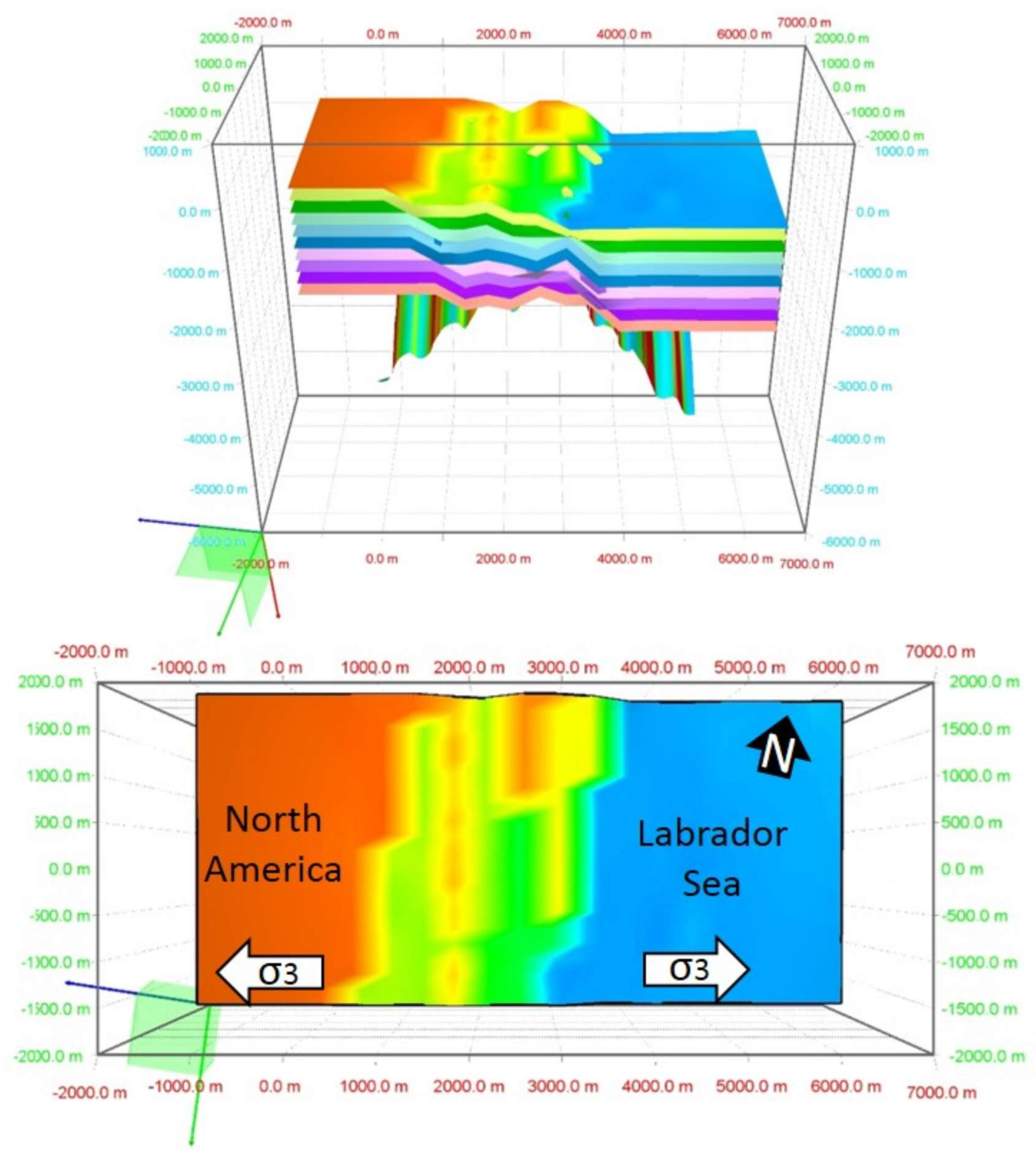
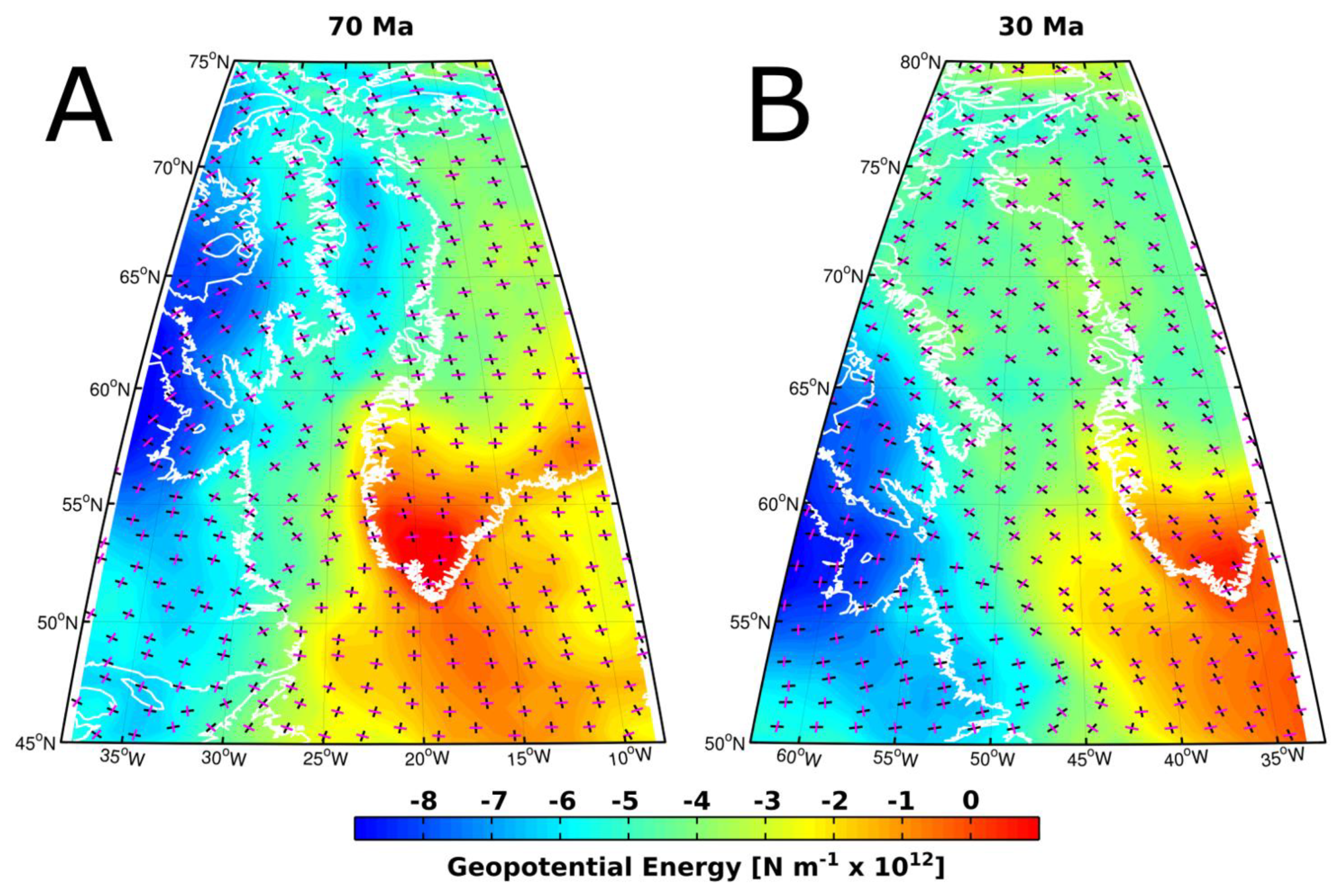
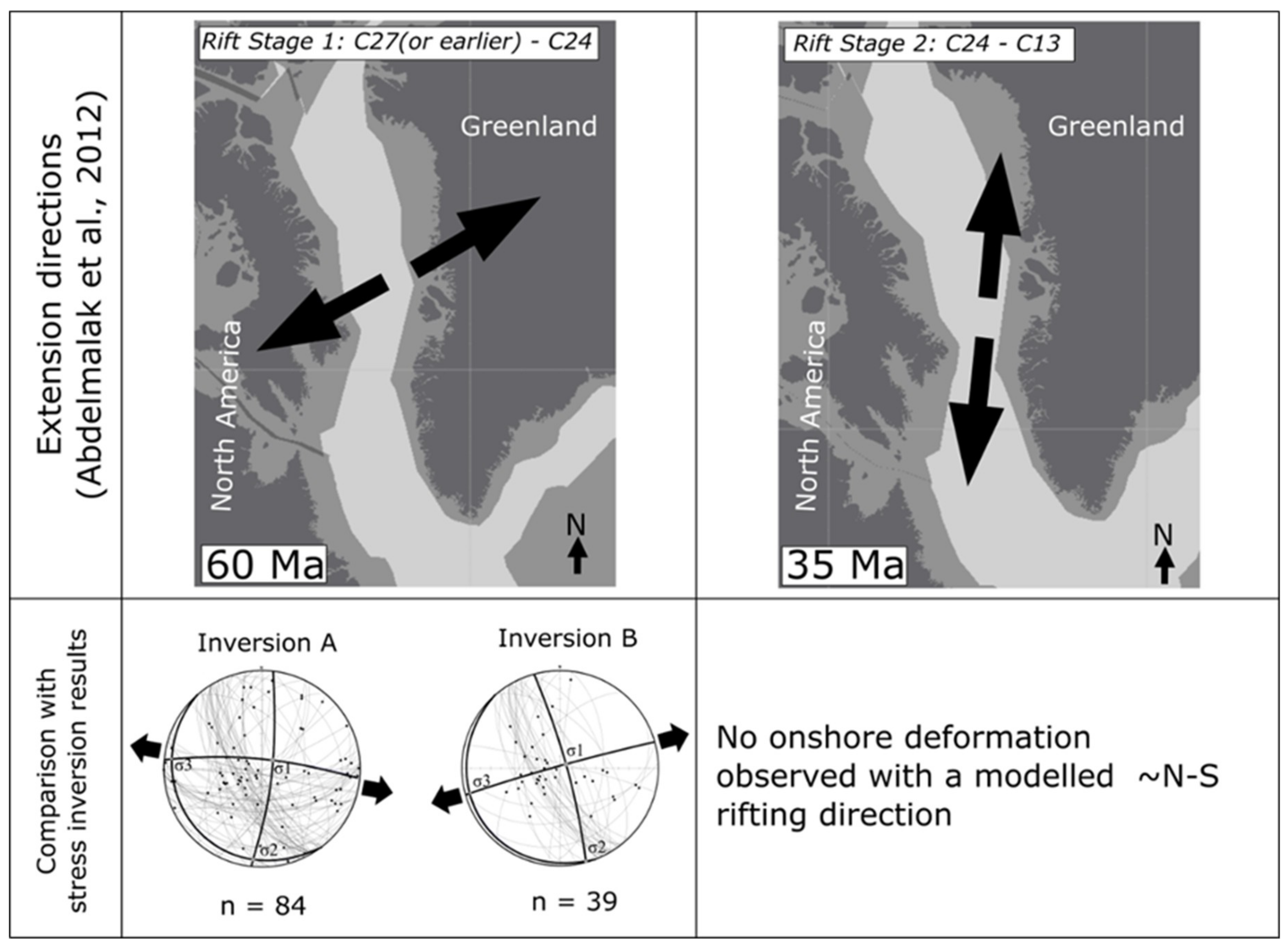
| Principal Stress Axis | Azimuth | Plunge |
|---|---|---|
| σ1 | 051° | 78° |
| σ2 | 185° | 8° |
| σ3 | 276° | 8° |
| Principal Stress Axis | Azimuth | Plunge |
|---|---|---|
| σ1 | 056° | 84° |
| σ2 | 164° | 2° |
| σ3 | 254° | 6° |
© 2018 by the authors. Licensee MDPI, Basel, Switzerland. This article is an open access article distributed under the terms and conditions of the Creative Commons Attribution (CC BY) license (http://creativecommons.org/licenses/by/4.0/).
Share and Cite
Peace, A.L.; Dempsey, E.D.; Schiffer, C.; Welford, J.K.; McCaffrey, K.J.W.; Imber, J.; Phethean, J.J.J. Evidence for Basement Reactivation during the Opening of the Labrador Sea from the Makkovik Province, Labrador, Canada: Insights from Field Data and Numerical Models. Geosciences 2018, 8, 308. https://doi.org/10.3390/geosciences8080308
Peace AL, Dempsey ED, Schiffer C, Welford JK, McCaffrey KJW, Imber J, Phethean JJJ. Evidence for Basement Reactivation during the Opening of the Labrador Sea from the Makkovik Province, Labrador, Canada: Insights from Field Data and Numerical Models. Geosciences. 2018; 8(8):308. https://doi.org/10.3390/geosciences8080308
Chicago/Turabian StylePeace, Alexander L., Edward D. Dempsey, Christian Schiffer, J. Kim Welford, Ken J. W. McCaffrey, Jonathan Imber, and Jordan J. J. Phethean. 2018. "Evidence for Basement Reactivation during the Opening of the Labrador Sea from the Makkovik Province, Labrador, Canada: Insights from Field Data and Numerical Models" Geosciences 8, no. 8: 308. https://doi.org/10.3390/geosciences8080308




